You’ll see sunlight spilling through a moss-lined travertine arch as you step onto the overlook, a quiet moment worth planning for. You’ll learn the drive, trail options, best seasons and practical tips so you don’t waste time once you arrive. Expect straightforward directions from Phoenix, limited parking, and short but steep trails that reward you with waterfall and canyon views. Keep going to get the logistical details you’ll need.
Why Tonto Natural Bridge State Park Is Worth Visiting
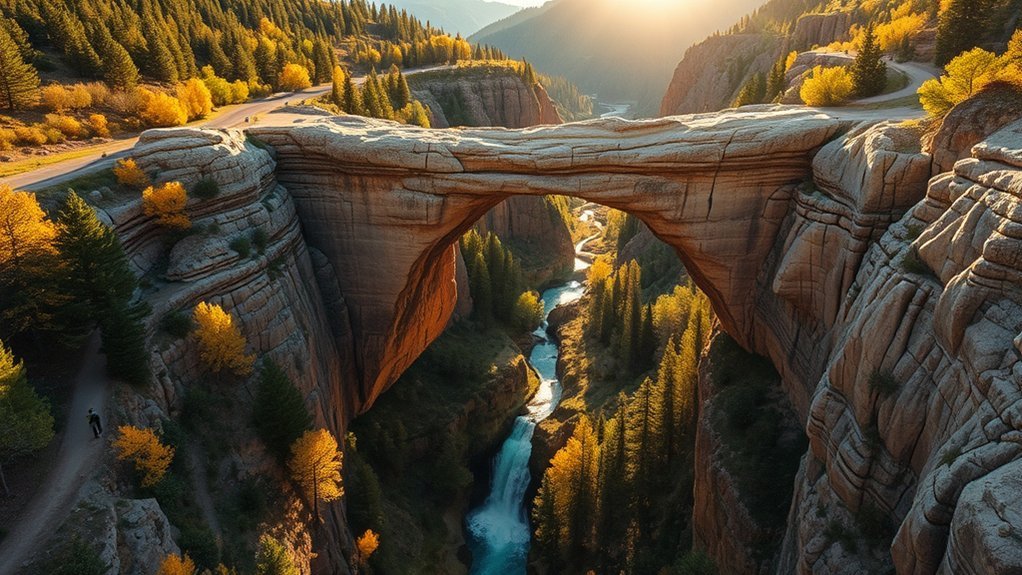
When you step onto the trails at Tonto Natural Bridge State Park, you’ll immediately see why it’s worth a visit: the world’s largest natural travertine bridge arches over a verdant canyon, creating dramatic views, shaded grottoes, and easy access to hiking and photography spots. You’ll encounter a natural wonder formed by mineral-rich springs that deposited travertine over millennia, producing fragile but striking rock formations. Trails and overlooks let you study layers, flow patterns, and spring-fed pools that illustrate the site’s geological significance. You’ll appreciate clear interpretive signs and manageable routes that suit casual visitors and experienced hikers alike. Bring a camera, sturdy shoes, and curiosity—this compact park delivers concentrated, educational scenery without long backcountry commitments.
Where the Park Is Located and How to Get There
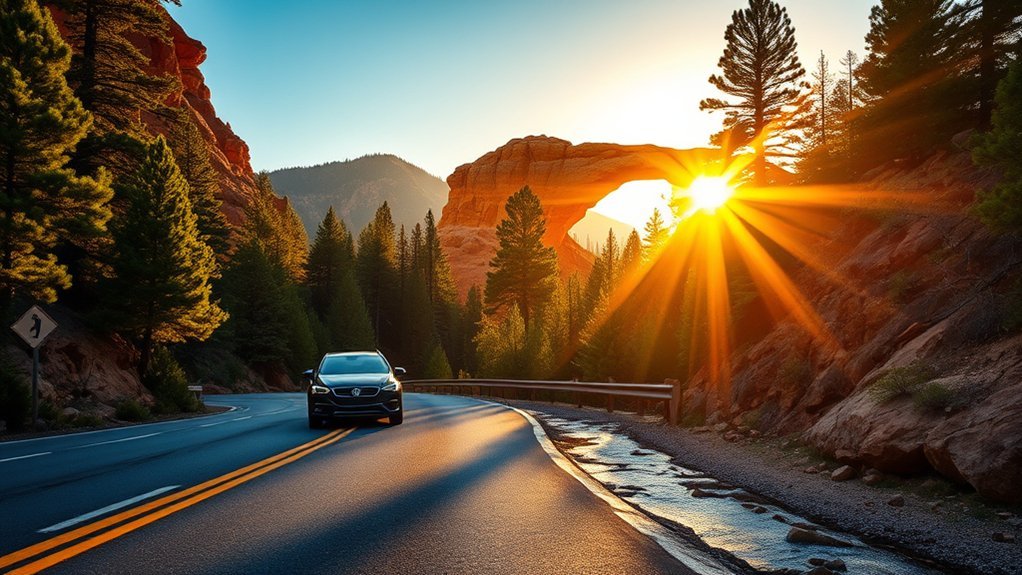
Although it feels tucked away, Tonto Natural Bridge State Park sits in central Arizona’s high desert near the town of Payson — about 100 miles northeast of Phoenix — and is easily reached by car via State Route 87 and Forest Road 289A. You’ll find clear signage from Payson; GPS recognizes the park as “Tonto Natural Bridge.” Park Location is remote, so plan fuel and supplies before you leave town. For Getting There, use a vehicle with good clearance if you detour onto unpaved forest roads. Follow posted parking instructions and buy an entry pass at the kiosk. Travel Tips: cell service is spotty, bring water, and check road conditions in winter or after storms.
Tucked in central Arizona near Payson, Tonto Natural Bridge is reachable via SR‑87 and Forest Road 289A—plan fuel, water, and limited cell service.
- Drive SR-87 to Payson, then follow local signs.
- Use Forest Road 289A for the final approach.
- Fill fuel and carry water before arrival.
- Expect limited cell service; print directions.
Best Times of Year and Day to Visit
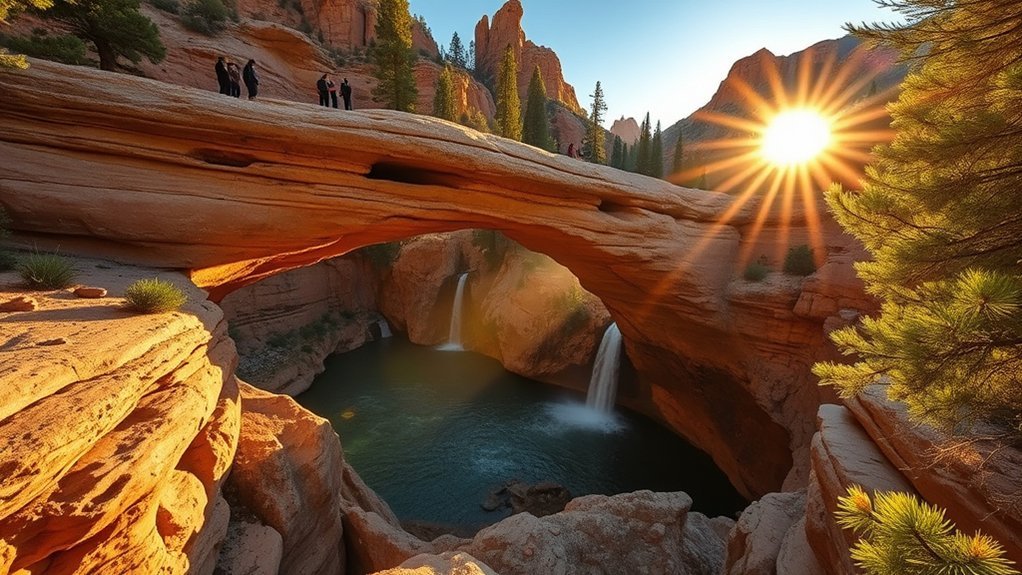
Because the park sits at roughly 5,000 feet elevation, spring and fall offer the most comfortable weather and the best trail conditions—visit March through May or September through October for mild temperatures, blooming desert plants in spring, and vivid fall colors. Those are the best seasons for hiking, photography, and avoiding extreme heat. Mornings are cooler and less crowded, so plan to arrive during early peak hours for softer light and safer trail footing. Late afternoon offers good light but can be busier; aim to finish hikes before sunset to avoid maneuvering in fading light. Winter brings cooler, occasionally icy conditions, and summer can be hot and monsoon-prone—adjust plans accordingly. Check forecasts and pack layers.
Parking, Fees, and Park Hours
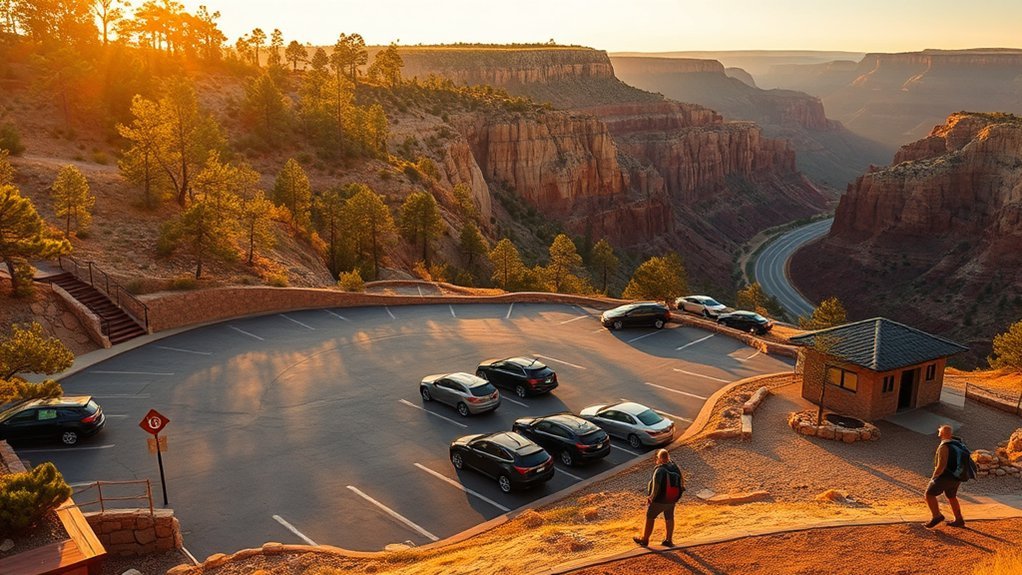
You’ll find a small paved parking lot at the Tonto Natural Bridge State Park trailhead with limited spaces, so plan to arrive early on busy weekends or holidays to secure a spot. Park staff monitor flow; overflow street parking is limited and discouraged. Check current parking options before you go, especially if you need an ADA-accessible space.
- Entrance fees: pay at the kiosk or online; fees support maintenance and are posted on the state park site.
- Daily hours: the park typically opens at sunrise and closes at sunset — confirm seasonal changes.
- Seasonal closures: some facilities or gates may close in winter or for maintenance; verify ahead.
- Accessibility: limited paved paths and designated spaces; contact the park for specific needs.
Main Trails and Viewpoints to Explore
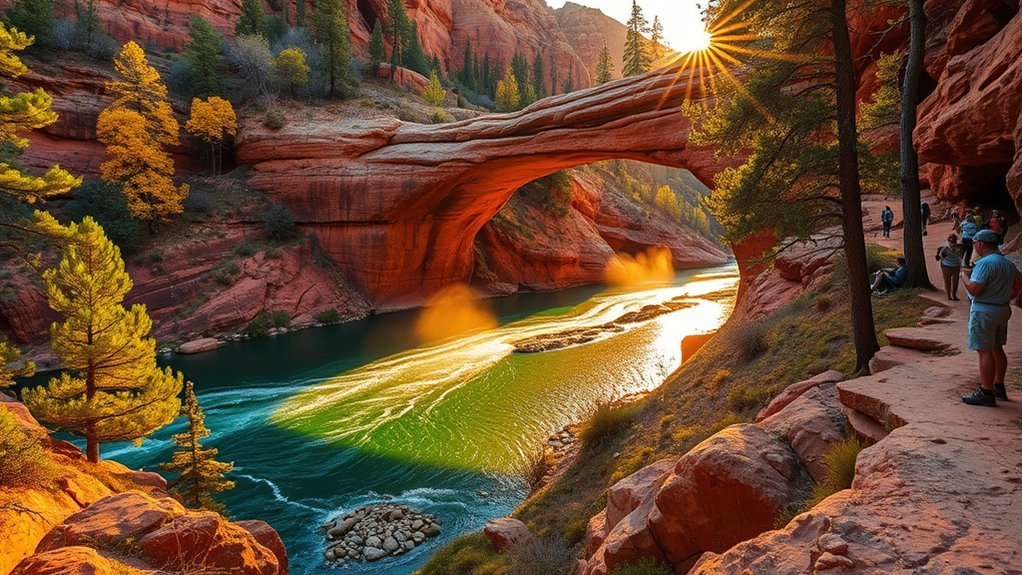
You’ll want to start with the Pine Creek Trail, which drops into the canyon and gives you close-up views of the bridge’s underside. From the rim, the Waterfall Overlook Trail offers a short, accessible walk to an excellent vantage point of the falls and surrounding rock formations. Both trails are well-marked and reward you with contrasting perspectives, so plan time for each.
Pine Creek Trail
When you follow the Pine Creek Trail, expect a well-marked path that drops from the rim into the shade of pinyon and juniper toward the park’s namesake bridge; the route offers several viewpoints and short spur trails that let you linger at cascades, pools, and limestone cliffs. You’ll descend gradually, cross small gullies, and track pine creek as it carves the canyon. The trail’s surface is mostly packed dirt with some rock steps; sturdy shoes help. Watch for interpretive signs describing geology and local plants. Take your time at each outlook for scenic views and photo opportunities. Plan 45–90 minutes round-trip depending on stops; bring water and sun protection.
- Moderate descent and return
- Multiple short spurs
- Pine creek crossings
- Scenic views and overlooks
Waterfall Overlook Trail
Although shorter than Pine Creek Trail, the Waterfall Overlook Trail delivers a direct, family-friendly route to the park’s most dramatic falls and viewpoints, so plan for a brief but rewarding walk. You’ll follow a well-marked path with modest grades and sturdy railings that guide you to multiple scenic viewpoints overlooking cascades and the bridge’s underside. Expect compacted dirt and steps; sturdy shoes are sufficient. For waterfall photography, arrive mid-morning or late afternoon for soft light and avoid harsh midday glare. Use a small tripod or steady your camera on a railing for slower shutter speeds to capture silky water. Interpretive signs explain geology and hydrology, so pause to learn. The trail is short, accessible, and delivers big views without a long hike.
What to Pack and Safety Tips
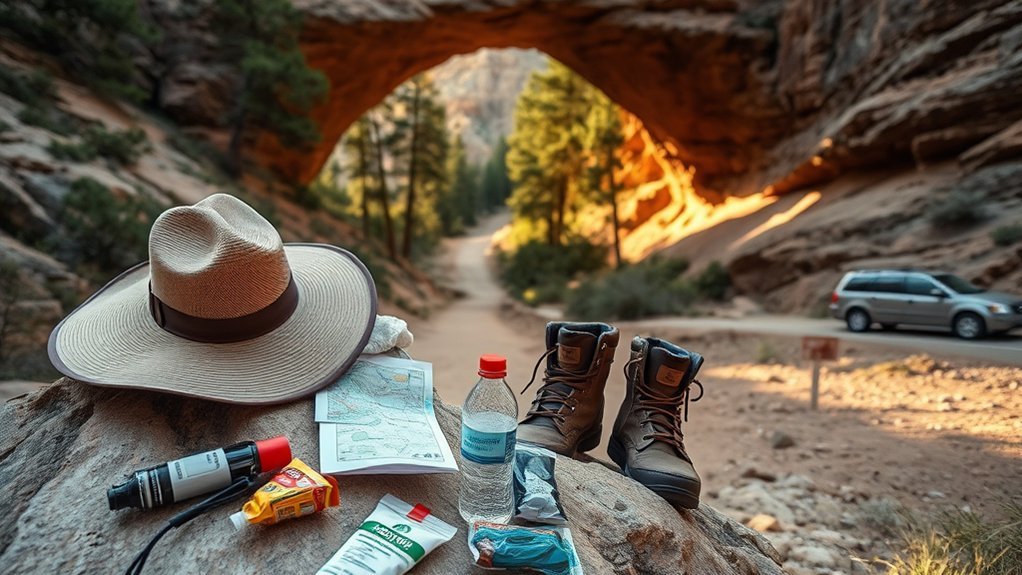
Before you hit the trails at Tonto Natural Bridge, pack the essentials: sturdy shoes, plenty of water, sun protection, a map or phone with offline directions, and a basic first-aid kit. Stay aware of footing on uneven or wet paths, watch for sudden weather changes, and stick to marked trails to protect both yourself and the fragile environment. Follow trail etiquette, tell someone your plans, and adjust gear for season and daylight to stay safe.
Essential Gear List
A compact kit tailored to Tonto Natural Bridge will keep you safe and comfortable on the trails: focus on gear essentials and a clear packing checklist so you don’t overpack or miss must-haves. Choose versatile, lightweight items and prioritize hydration, sun protection, and reliable footwear. Carry a basic first-aid kit and navigation aids even for short hikes.
- Water (1–2 liters), electrolyte mix, and a lightweight hydration pack.
- Sun protection: broad-brim hat, SPF 30+ sunscreen, UV sunglasses.
- Footwear and clothing: sturdy hiking shoes, moisture-wicking layers, light rain shell.
- Essentials: compact first-aid kit, headlamp, multitool, map/charged phone with offline maps.
Pack intentionally; review your packing checklist before you leave.
Safety & Trail Tips
When you’re planning hikes at Tonto Natural Bridge, pack smart and respect the elements to keep outings safe and enjoyable. Bring layers, sun protection, sturdy shoes, a headlamp, and at least two liters of water per person; add electrolyte tablets in summer. Carry a basic first-aid kit, map, whistle, and a charged phone or GPS device. Tell someone your route and expected return time. Stay on marked trails, know your limits on steep or slick sections, and turn back if conditions worsen. Practice wildlife safety: give animals space, don’t feed or approach them, store food securely, and know what to do if you encounter snakes or javelina. Observe trail etiquette—yield uphill, keep dogs leashed, and pack out all trash.
Nearby Attractions and Places to Eat
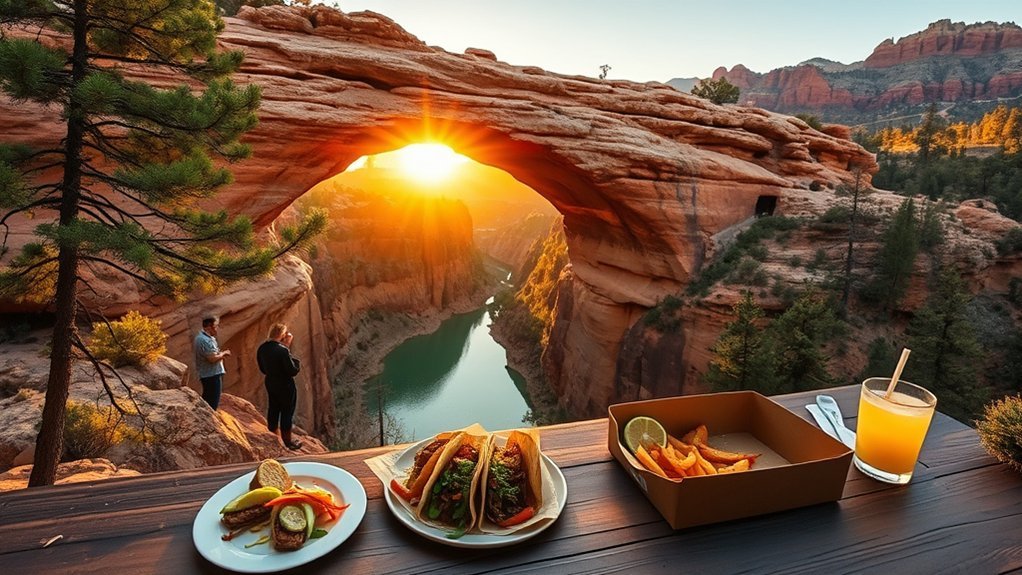
Although the park itself offers plenty to explore, you’ll want to set aside time to visit nearby sights and local eateries that complement the Tonto Natural Bridge experience. You’ll find casual local dining in Payson and Pine, from diners serving hearty breakfasts to cafés with regional ingredients. Plan stops that extend your outdoor day—scenic overlooks, small museums, and historic downtown streets provide context and photos.
Although the park rewards exploration, set aside time for nearby cafés, scenic overlooks, small museums, and charming downtown stops.
- Payson: cafes, breweries, grocery for picnic supplies.
- Pine/Strawberry: bakeries, art galleries, and antiques.
- Tonto Basin & Roosevelt Lake: viewpoints and boat-launch picnic spots.
- Rim Country trails: short detours to overlooks and interpretive signs.
Choose places open seasonally, call ahead for hours, and map routes before you go.
Accessibility and Family-Friendly Options
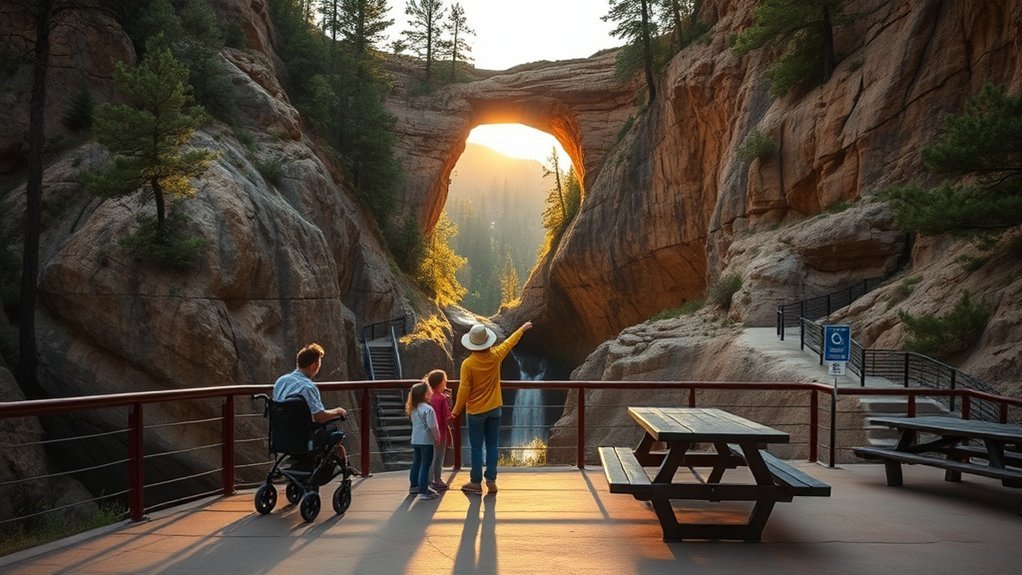
If you need easier access or are bringing kids, Tonto Natural Bridge State Park offers several family-friendly features and manageable routes that make the main viewpoints reachable without strenuous hiking. You’ll find paved areas near the parking lot, accessible restrooms, and designated wheelchair access to viewpoints overlooking the bridge. Trails to lower viewpoints include steps and uneven surfaces, so plan accordingly if mobility is limited. For families, ranger-led programs and short interpretive trails count as kid friendly activities that engage children without long treks. Bring a stroller suitable for rough paths or a sturdy carrier for littler ones. Check seasonal hours and ranger schedules before you go, and arrive early for parking close to accessible facilities and quieter, safer exploration.
Frequently Asked Questions
Are Pets Allowed on Park Trails and in Picnic Areas?
Yes — you can bring pets, but pet policies require leashes and supervision; trail restrictions prohibit pets on certain sensitive paths and inside some picnic shelters. You’re responsible for cleanup and following posted rules to avoid fines.
Is Drone Use Permitted Within Park Boundaries?
No, you can’t fly drones inside the park; state drone regulations prohibit unmanned aircraft to protect wildlife and visitors. For authorized aerial photography, contact park management for permits and follow FAA rules, time restrictions, and safety guidelines.
Are There Guided Tours or Ranger-Led Programs Available?
Yes — you can join guided nature walks and occasional educational programs led by park staff or volunteers; check the visitor center or park website for schedules, seasonal offerings, and special ranger-led events before your visit.
Can I Host a Small Wedding or Commercial Photoshoot at the Park?
Yes — you can, but you’ll need wedding permits and must follow photography guidelines; contact park staff to reserve sites, get permits, confirm group size limits, staging rules, timing, and any fees so your ceremony won’t disrupt habitat.
Is There Cell Phone Service or Wi-Fi Within the Park?
You won’t rely on strong cell service availability or wi fi access inside the park; reception’s spotty. You should plan for limited connectivity, download maps and notify others beforehand, and use offline resources while visiting the park.
Conclusion
Tonto Natural Bridge rewards you with dramatic travertine formations and peaceful trails — plan ahead, arrive early, and expect limited cell service. Hike Pine Creek or the Waterfall Overlook, pack water, sturdy shoes, and sun protection, and visit in spring or fall for best conditions. For example, a Phoenix couple drove 100 miles on SR‑87, caught sunrise at the bridge, and enjoyed uncrowded views on Pine Creek Trail — a simple, unforgettable day trip.

